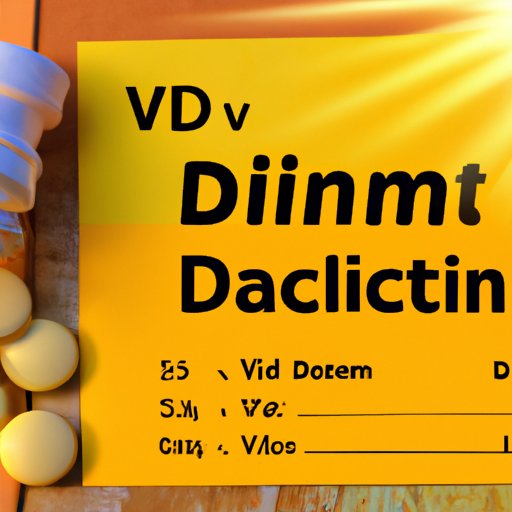
Introduction
Vitamin D is a crucial nutrient required for the proper functioning of our bodies. Along with promoting bone and muscle health, it also supports the immune system and reduces inflammation. However, many people are unaware of how much vitamin D they need to maintain good health. In this article, we’ll explore the recommended daily intake of vitamin D, the benefits and risks of getting too much or too little, and how to naturally boost your vitamin D levels.
The Ultimate Guide to Vitamin D: How Much Do You Really Need?
According to the National Institutes of Health (NIH), the recommended daily intake of vitamin D for adults is 600-800 IU per day. However, depending on factors such as age, geographic location, and skin color, some people may require more. For instance, as we age, our bodies become less efficient in producing vitamin D, and people living in northern latitudes where sunlight is scarce may require more vitamin D intake.
Individuals who are at risk of vitamin D deficiency are those who spend most of their time indoors, people with darker skin tones, older adults, and those with certain medical conditions such as inflammatory bowel diseases or liver or kidney diseases.
Wondering how to determine if you’re getting enough vitamin D? The easiest way is to get a blood test done to check your vitamin D levels. Ask your doctor for a 25-hydroxy vitamin D test, which measures the level of vitamin D in your blood.
The Benefits of Vitamin D: Why You Need It and How to Get It
Vitamin D has numerous health benefits and plays a crucial role in promoting bone and muscle health. It also impacts the immune system, reduces inflammation, and influences mental health. Studies have shown that maintaining optimal levels of vitamin D can reduce the risk of various chronic diseases such as heart disease, diabetes, and multiple sclerosis.
One of the best ways to get vitamin D is through sunlight exposure. When your skin is exposed to sunlight, it produces vitamin D3, which is then converted to its active form by the liver and kidneys. However, too much sunlight exposure can also be harmful and increase the risk of skin cancer. Thus, it’s essential to practice safe sun exposure by wearing protective clothing and using sunscreen.
Dietary sources of vitamin D include fatty fish such as salmon, tuna, and mackerel, egg yolks, and fortified foods such as milk, cereal, and orange juice. However, it may be challenging to meet the daily recommended intake of vitamin D through diet alone.
Top 5 Signs You’re Not Getting Enough Vitamin D
One of the top signs you’re not getting enough vitamin D is fatigue and tiredness, as vitamin D impacts muscle strength and function. Other signs include frequent bone fractures, muscle weakness, depression, compromised immune function, and slow wound healing.
Vitamin D deficiency can occur due to various reasons such as inadequate dietary intake, lack of sunlight exposure, medical conditions that affect vitamin D absorption, and certain medications that interfere with vitamin D metabolism.
If you suspect that you’re deficient in vitamin D, it’s essential to consult your healthcare provider and get a blood test done. Depending on your results, they may recommend supplements or dietary changes to address the issue.
How to Boost Your Vitamin D Levels Naturally
To boost your vitamin D levels naturally, try spending more time outdoors in the sunlight. Aim for 15-20 minutes of sunlight exposure on bare arms and legs, two to three times a week. Additionally, swap out fatty, processed foods for vitamin D-rich foods such as salmon, egg yolks, and fortified cereals. If you have trouble meeting your daily vitamin D requirements through diet and sunlight exposure, talk to your healthcare provider about taking a vitamin D supplement.
It’s also essential to maintain a healthy lifestyle by exercising regularly, getting adequate sleep, and managing stress levels, as it impacts overall health, including vitamin D levels.
Vitamin D vs. Vitamin D3: What’s the Difference?
There are two different forms of vitamin D: vitamin D2 and vitamin D3. Vitamin D2 is produced by plants and is commonly found in fortified foods such as cereal and orange juice. Meanwhile, vitamin D3 is produced by our skin in response to sunlight exposure and is also found in foods such as fatty fish, egg yolks, and liver.
Research has shown that vitamin D3 is more effective in raising and maintaining adequate vitamin D levels than vitamin D2. Thus, it’s recommended that individuals supplement with vitamin D3 instead of vitamin D2. However, if you’re a vegan or vegetarian, you may need to supplement with vitamin D2 as it’s the only plant-based source of vitamin D.
The Risks of Too Much Vitamin D: What You Need to Know
While vitamin D is essential for good health, consuming too much can be harmful and lead to vitamin D toxicity. Symptoms of vitamin D toxicity include nausea, vomiting, and fatigue, and in severe cases, it can lead to kidney stones and tissue damage. It’s essential to follow the recommended daily intake and not exceed 4000 IU per day without consulting your healthcare provider.
If you’re taking supplements, be sure to read the label and ensure that you’re taking the recommended dosage. Additionally, it’s essential to inform your healthcare provider about any supplements you’re taking, as some medications may interact with high vitamin D intake.
Conclusion
Vitamin D is a crucial nutrient required for optimal health and is essential for various bodily functions. Maintaining optimal levels of vitamin D can reduce the risk of various chronic diseases and promote bone and muscle health. To ensure you’re getting enough vitamin D, aim for regular sunlight exposure, consume vitamin D-rich foods, and consider taking supplements if necessary. If you’re concerned about your vitamin D levels, be sure to consult your healthcare provider.




